7 Ways to Automate Personalized Content in Your B2B Marketing Strategy
Generic marketing messages no longer cut it. With 86% of B2B marketers agreeing that personalized content is key to success, the challenge lies in delivering tailored experiences at scale. This guide provides practical automation strategies to personalize your B2B content marketing efforts, and shows you how leveraging the right tools and technologies can transform your customer engagement while saving valuable time and resources.
Key Takeaways
- Data Integration Is Foundational: Unify your customer data sources to create comprehensive profiles that power personalization.
- AI-Powered Content Generation: Leverage artificial intelligence to create customized content variations efficiently.
- Dynamic Email Personalization: Implement automated systems that deliver highly relevant email content based on recipient behavior and preferences.
- Segmentation Beyond Demographics: Utilize behavioral and intent data to create hyper-targeted content for specific audience segments.
- Automated Content Distribution: Deploy cross-channel automation to deliver the right content at the right time on the right platform.
- Performance Measurement: Implement systems that automatically track, analyze, and optimize personalized content performance.
- Scalable Personalization Framework: Build a technology stack that allows personalization to grow with your business needs.
TABLE OF CONTENTS:
The Personalization Imperative in B2B Marketing
The B2B buying journey has evolved dramatically. Today’s business buyers expect the same level of personalization they experience as consumers. According to research from Demand Gen Report, 86% of B2B marketers agree that personalized content is essential for success in today’s market.
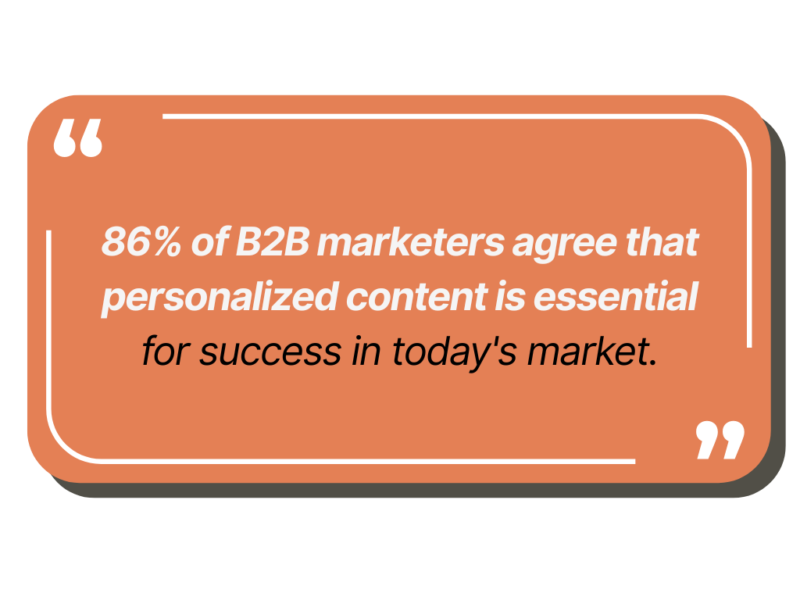
This shift is driven by changing buyer expectations and the increasing complexity of the B2B purchase process. With multiple stakeholders involved in buying decisions and longer sales cycles, generic content simply doesn’t resonate. Personalized content that addresses specific pain points, industry challenges, and individual roles within the buying committee has become a necessity rather than a luxury.
However, creating personalized content at scale presents significant challenges. Many B2B marketers struggle with fragmented data, siloed systems, and resource constraints. This is where automation becomes critical—enabling marketers to deliver personalized experiences efficiently and effectively.
Single Grain’s content marketing experts understand these challenges and have developed strategies to help B2B companies implement personalization at scale through intelligent automation.
7 Powerful Ways to Automate Personalized Content
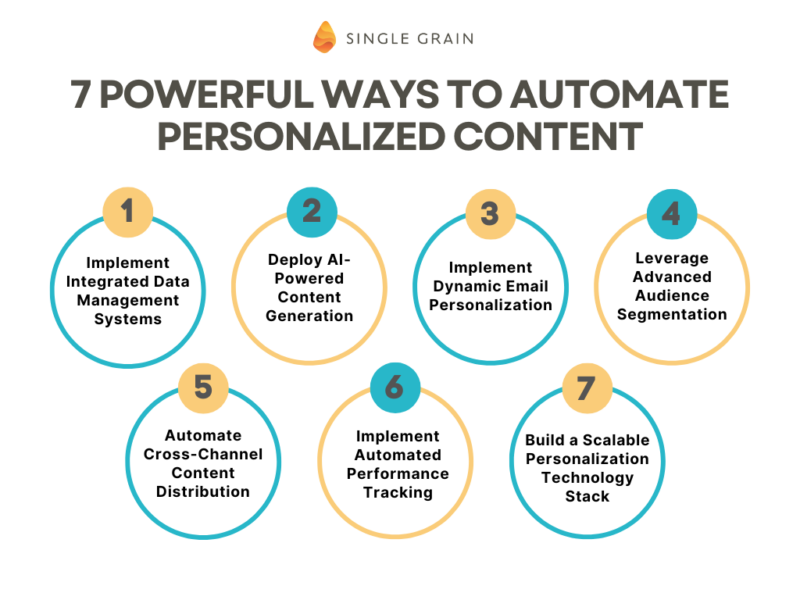
1. Implement Integrated Data Management Systems
The foundation of effective personalization is comprehensive, accurate data. Automating your data collection and integration processes ensures you have the insights needed to personalize effectively.
Key automation strategies:
- CRM Integration: Automatically sync customer data between your CRM and marketing platforms to maintain a single source of truth.
- Behavioral Tracking: Implement tools that automatically capture and analyze website behavior, content engagement, and purchase history.
- Progressive Profiling: Use forms that intelligently gather additional information over time, building richer customer profiles with each interaction.
According to research by Epsilon, 72% of B2B marketers found CRM systems most beneficial in tailoring their marketing efforts. By automating the flow of data between systems, you create a foundation for personalization that’s both comprehensive and current.
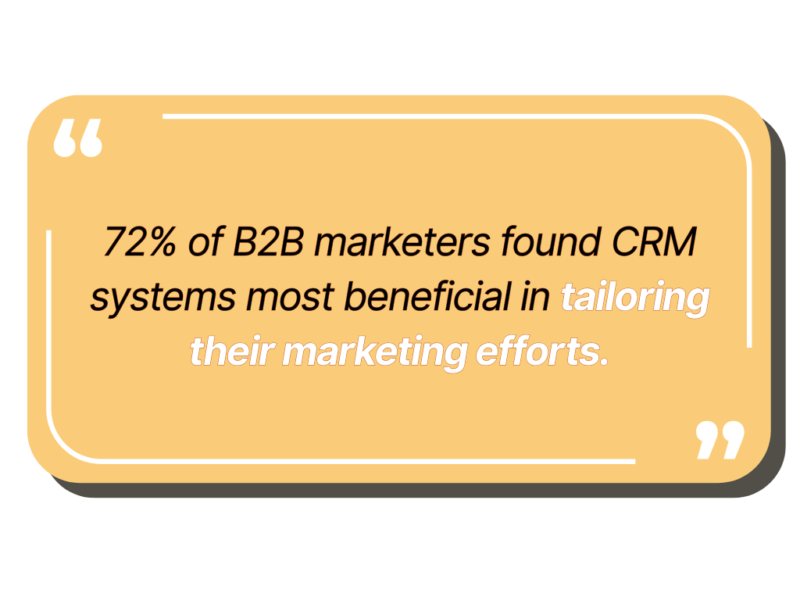
2. Deploy AI-Powered Content Generation
Artificial intelligence has revolutionized content creation, making it possible to generate personalized content variations at scale.
Key automation strategies:
- Dynamic Content Blocks: Create modular content components that automatically adjust based on audience attributes.
- AI Writing Assistants: Leverage tools that can generate personalized copy variations for different segments.
- Automated Content Optimization: Use AI to test and refine messaging for different audience segments.
Single Grain’s AI-driven content workflows enable B2B marketers to produce high-quality, personalized content much faster than traditional methods, without sacrificing quality.
3. Implement Dynamic Email Personalization
Email remains one of the most effective B2B marketing channels, and automation makes it possible to deliver highly personalized messages at scale.
Key automation strategies:
- Triggered Email Sequences: Set up automated workflows that send personalized emails based on specific actions or behaviors.
- Dynamic Content Insertion: Implement systems that automatically customize email content based on recipient data.
- Send-Time Optimization: Use AI to automatically determine the optimal time to send emails to each recipient.
A study by Campaign Monitor found that personalized email subject lines increase open rates by 26%, while personalized email content can increase click-through rates by up to 14%. By automating these personalization elements, you can achieve these benefits without manual intervention.
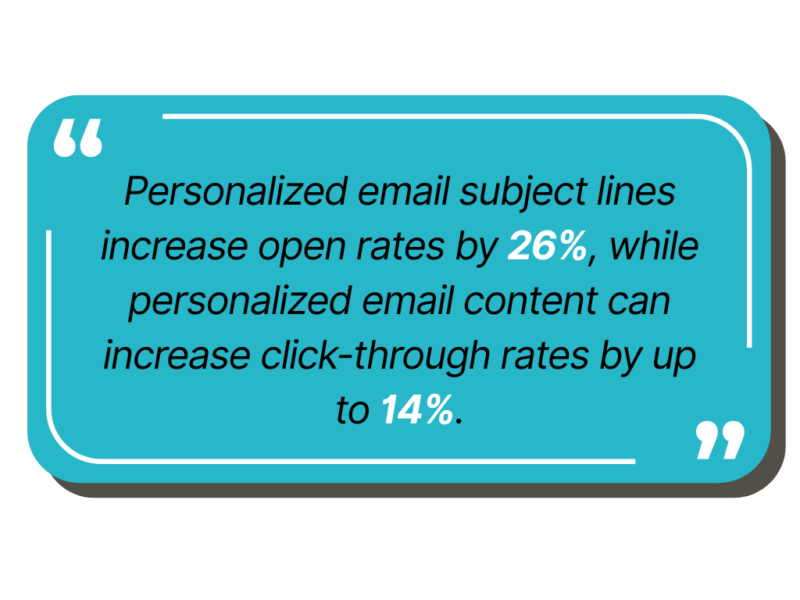
4. Leverage Advanced Audience Segmentation
Moving beyond basic demographic segmentation allows for more nuanced personalization that resonates with specific audience needs.
Key automation strategies:
- Behavioral Segmentation: Automatically group contacts based on their interactions with your content and website.
- Intent Signals: Use AI to identify and categorize buying signals that indicate specific interests or needs.
- Account-Based Segmentation: Implement tools that automatically identify and group contacts from the same organization.
For B2B companies implementing account-based marketing strategies, Karrot.ai offers advanced segmentation capabilities that enable hyper-personalized content delivery to key accounts, significantly improving engagement rates.
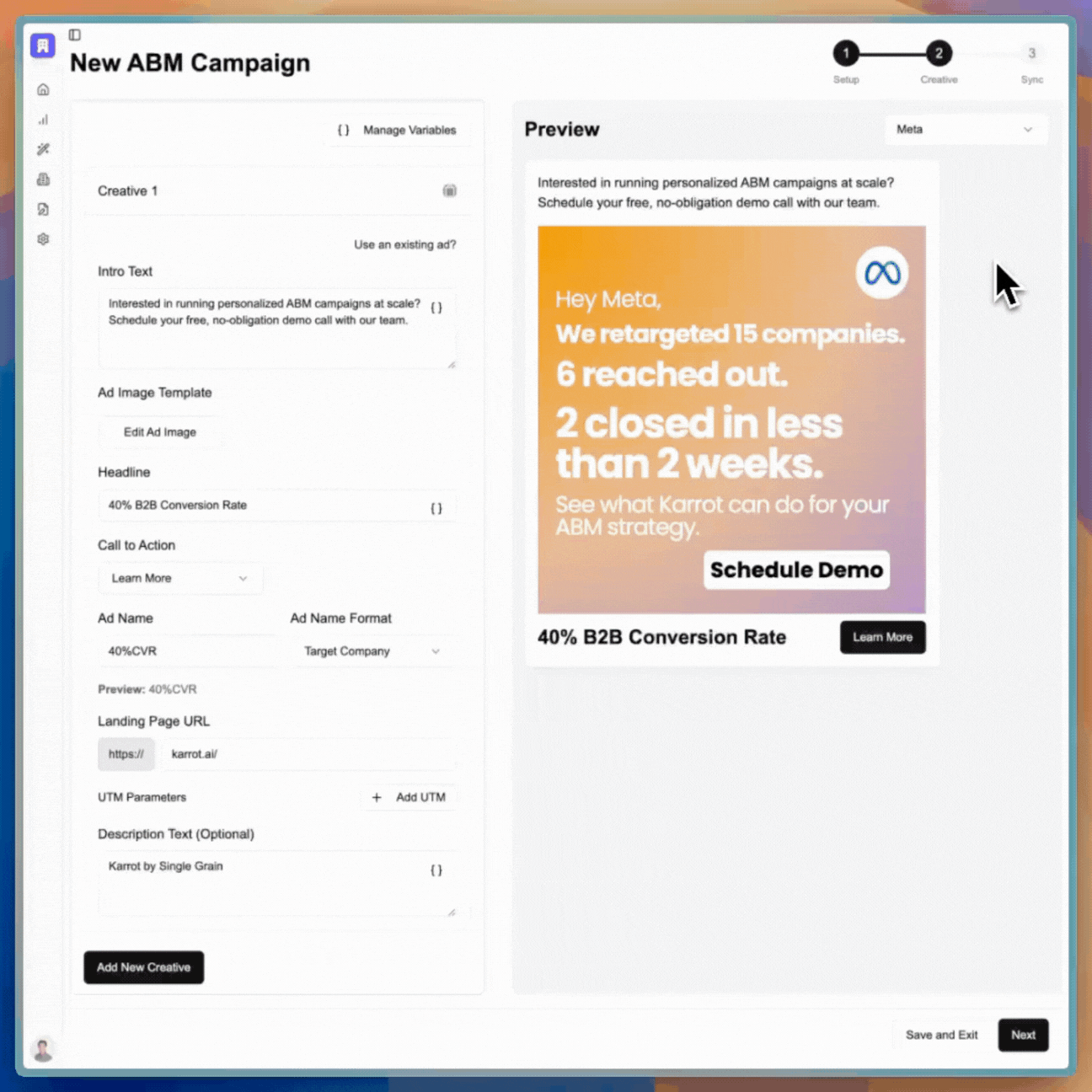
5. Automate Cross-Channel Content Distribution
Ensuring your personalized content reaches your audience on their preferred channels is critical for engagement.
Key automation strategies:
- Content Scheduling: Implement tools that automatically publish content across channels at optimal times.
- Channel-Specific Formatting: Use automation to adapt content for different platforms while maintaining personalization.
- Retargeting Integration: Set up systems that automatically serve personalized ads based on previous content interactions.
According to research from Omnisend, marketing campaigns using three or more channels earned a 287% higher purchase rate than single-channel campaigns. Automation makes this multi-channel approach manageable and effective.

6. Implement Automated Performance Tracking
Understanding how your personalized content performs is essential for continuous improvement.
Key automation strategies:
- Real-Time Analytics: Deploy systems that automatically track engagement metrics across all personalized content.
- Attribution Modeling: Implement tools that automatically attribute conversions to specific personalized content pieces.
- Automated Reporting: Set up dashboards that provide real-time insights into personalization effectiveness.
Single Grain’s SEO services include automated performance tracking that helps B2B marketers understand how their personalized content impacts search visibility and engagement metrics.
7. Build a Scalable Personalization Technology Stack
Creating a technology ecosystem that supports growing personalization needs is crucial for long-term success.
Key automation strategies:
- API Integrations: Implement systems that communicate seamlessly through APIs to share personalization data.
- Modular MarTech Stack: Build a flexible technology infrastructure that can adapt as personalization needs evolve.
- Automation Workflows: Create end-to-end workflows that connect personalization across the customer journey.
Personalization Automation in Action: A Practical Framework
To implement these automation strategies effectively, consider this practical framework:
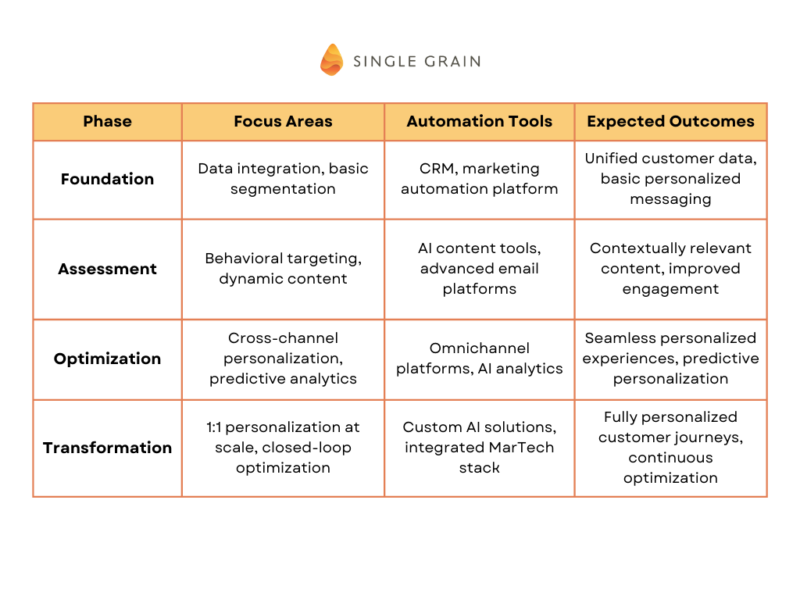
This phased approach allows B2B marketers to build personalization capabilities incrementally, ensuring each automation element is properly implemented before moving to more advanced strategies.
Final Thoughts
Automating personalized content in your B2B marketing strategy is no longer optional—it’s essential for staying competitive in today’s market. By implementing these seven automation strategies, you can deliver the personalized experiences your customers expect while operating efficiently at scale.
Remember that effective personalization automation is a journey, not a destination. Start with the fundamentals of data integration and basic segmentation, then gradually incorporate more sophisticated automation capabilities as your strategy matures.
Single Grain’s conversion rate optimization experts can help you develop and implement a personalization automation strategy that drives engagement, conversions, and loyalty throughout the B2B customer journey. By combining the right technology with strategic expertise, you can transform your B2B marketing approach and achieve sustainable competitive advantage through personalization at scale.




